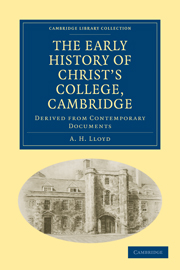Book contents
- Frontmatter
- Preface
- Contents
- LIST OF ILLUSTRATIONS
- List of Abbreviations
- Chronological Summary
- Dedication
- Chapter I William Byngham, the First Founder
- Chapter II The Dispute with John Langton
- Chapter III The First Royal Licence, 1439
- Chapter IV The Expansion of the Milne Street Site
- Chapter V The Royal Licences of 1442
- Chapter VI Marking Time: 1443 to 1446
- Chapter VII The Royal Licence of 1446 and its period
- Chapter VIII The Foundation Charter of the College of Godshouse and its period
- Chapter IX The Relationship of Godshouse and Clare Hall
- Chapter X The Last Days of William Byngham
- Chapter XI The Proctorship of John Hurte, 1451–1458, and of William Fallan, 1458–1464
- Chapter XII The Proctorship of William Basset, 1464–1477
- Chapter XIII The Proctorship of Ralph Barton, 1477–1490
- Chapter XIV The Proctorship of John Syclyng: Early Years, 1490–1496
- Chapter XV The Proctorship of John Syclyng: Later Years, 1496–1506
- Chapter XVI The Negotiations between Godshouse and the Lady Margaret
- Chapter XVII Syclyng's Death and Will
- Chapter XVIII The Buildings and Furniture remaining from the Godshouse period
- Chapter XIX Godshouse and Christ's College
- Appendix
- Index
- Plate section
Chapter XVIII - The Buildings and Furniture remaining from the Godshouse period
Published online by Cambridge University Press: 05 October 2010
- Frontmatter
- Preface
- Contents
- LIST OF ILLUSTRATIONS
- List of Abbreviations
- Chronological Summary
- Dedication
- Chapter I William Byngham, the First Founder
- Chapter II The Dispute with John Langton
- Chapter III The First Royal Licence, 1439
- Chapter IV The Expansion of the Milne Street Site
- Chapter V The Royal Licences of 1442
- Chapter VI Marking Time: 1443 to 1446
- Chapter VII The Royal Licence of 1446 and its period
- Chapter VIII The Foundation Charter of the College of Godshouse and its period
- Chapter IX The Relationship of Godshouse and Clare Hall
- Chapter X The Last Days of William Byngham
- Chapter XI The Proctorship of John Hurte, 1451–1458, and of William Fallan, 1458–1464
- Chapter XII The Proctorship of William Basset, 1464–1477
- Chapter XIII The Proctorship of Ralph Barton, 1477–1490
- Chapter XIV The Proctorship of John Syclyng: Early Years, 1490–1496
- Chapter XV The Proctorship of John Syclyng: Later Years, 1496–1506
- Chapter XVI The Negotiations between Godshouse and the Lady Margaret
- Chapter XVII Syclyng's Death and Will
- Chapter XVIII The Buildings and Furniture remaining from the Godshouse period
- Chapter XIX Godshouse and Christ's College
- Appendix
- Index
- Plate section
Summary
The purchase of the Fishwick tenements by Basset in 1468 completed the site of Godshouse; thereafter it neither gained nor diminished in area up to the advent of the Lady Margaret. Even more may be said, for all her buildings were comprised within its space and the first structure placed upon land outside the Godshouse site was Fellows' Building, erected in 1640–2. The area thus attained in 1468 was nearly equal to the present open space of the Great Court of Trinity; to be more exact, the Great Court has an area of about ten thousand square yards while the site of Godshouse occupied about nine thousand. The development since 1448, when the tenements of Tiltey and Denney alone were possessed, becomes impressive when it is recognised that, at the date when the Lady Margaret's statutes were given and accepted, the college possessed and had possessed for nearly forty years a site which already
had absorbed the full frontage to Preacher Street (St Andrew's Street) which it has to-day, from Walks Lane (Hobson Street) to Hangman's Lane or Rogues' Alley (Christ's Lane);
included the whole area of the present first court and ran back behind it to the watercourse, shewn in the plan, a few feet to the west of Fellows' Building;
included sufficient space behind the north range of the court to provide a marginal area between that range and the triangular space acquired 28 August 1507.
- Type
- Chapter
- Information
- The Early History of Christ’s College, CambridgeDerived from Contemporary Documents, pp. 313 - 340Publisher: Cambridge University PressPrint publication year: 2010First published in: 1934



